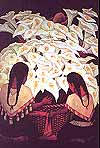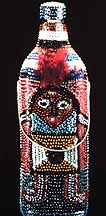O C T O B E R / N O V E M B E R
ArtEvents

Frida Kahlo, Self Portrait
as a Tehuanana (Diego on my mind)
1943. Oil on masonite

Diego Rivera, Vendedora de alcatraces (Calla lily vendor) 1943. Oil on masonite
North Miami's MOCA opened its doors in February '96, intent on bringing some much-needed fine arts culture to Miami. The 23,000 sq. ft. space was designed by the important architect Charles Gwathemey." The new museum has enabled us to mount major art exhibitions of national and international importance, and to expand our permanent collection," says director Lou Anne Colodny.
12,000 sq ft. are given over to exhibition space, housed in two areas. There is a gift shop, and an outdoor courtyard for performances, screenings and larger installations.
From October 4th to December 1st an exhibition," Mexican Modernism from the Jacques and Natasha Gelman Collection" will be open to the public. Miami MOCA is one of only two places to view this important collection , which features the works of such first-rank artists as Frida Kahlo, Jose Clemente Orozco, Diego Rivera, Carlos Merida David Alfaro Siqueros and Rufino Tamayo.
Several of Frida Kahlo's greatest and most famous paintings are on display, as well as some important work by her husband Diego Rivera. Fifteen artists in all are represented in this exciting collection, and a trip to MOCA for this show is essential for all enthusiasts of Mexican art, and art in general. MOCA will offer a series of lectures, films, tours and special events in conjunction with the the exhibition . Please call the museum at 305/893-6211 for details.
 MIAMI ART MUSEUM, formerly known as the center for the fine arts in downtown miami , is presenting an unusual and exciting exhibition starting Sept. 19.
MIAMI ART MUSEUM, formerly known as the center for the fine arts in downtown miami , is presenting an unusual and exciting exhibition starting Sept. 19.